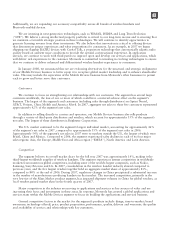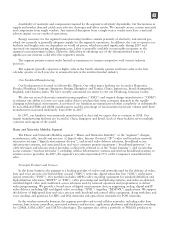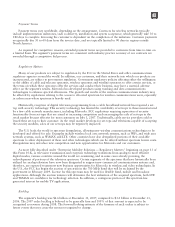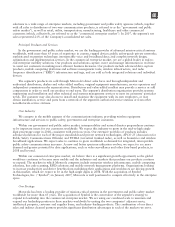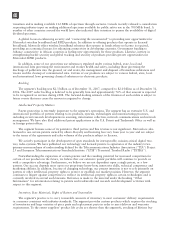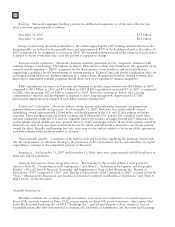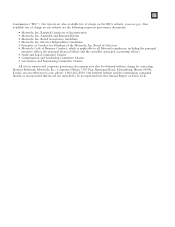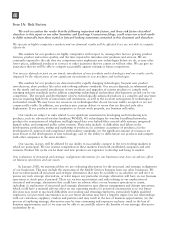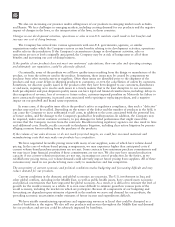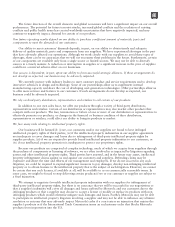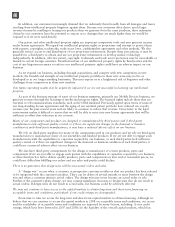Motorola 2007 Annual Report Download - page 21
Download and view the complete annual report
Please find page 21 of the 2007 Motorola annual report below. You can navigate through the pages in the report by either clicking on the pages listed below, or by using the keyword search tool below to find specific information within the annual report.
The commercial enterprise market is highly competitive and acutely influenced by advances in technology,
industry standards, product improvements, new product introductions and price competition. Many firms are
engaged in the manufacturing and marketing of products in bar code reading equipment, wireless networks and
mobile computing devices. Numerous companies, including present manufacturers of scanners, lasers, optical
instruments, microprocessors, wireless networks, notebook computers, handheld devices and telephonic and other
communication devices, have the technical potential to compete with the segment. Competitors such as Intermec,
Cisco and Nokia deliver products in certain parts of the commercial enterprise market.
Payment Terms
Payment terms vary worldwide. Generally, contract payment terms range from 30 to 60 days from the invoice
date within North America and are typically limited to 90 days in regions outside North America. A portion of the
contracts in the government and public safety market include implementation milestones, such as delivery,
installation and system acceptance, which generally take 30 to 180 days to complete. Invoicing the customer is
dependent on the completion of the milestone.
We generally do not grant extended payment terms. As required for competitive reasons, we may provide or
work with third-party lenders to arrange for long-term financing in connection with equipment purchases.
Financing may cover all or a portion of the purchase price.
Regulatory Matters
The use of wireless voice, data and video communications systems requires radio spectrum, which is regulated
by governmental agencies throughout the world. In the U.S., the FCC and the National Telecommunications and
Information Administration (“NTIA”) regulate spectrum use by non-federal entities and federal entities,
respectively. Similarly, countries around the world have one or more regulatory bodies that define and implement
the rules for use of the radio spectrum, pursuant to their respective national laws and international coordination
under the International Telecommunications Union (“ITU”). Consequently, the business and results of this segment
could be affected by the rules and regulations adopted by the FCC, NTIA or regulatory agencies in other countries
from time to time. The availability of additional radio spectrum may provide new business opportunities.
Regulatory changes in current spectrum bands may also provide opportunities or may require modifications to
some of our products so they can continue to be manufactured and marketed.
The segment manufactures and markets products in spectrum bands already made available by regulatory
bodies. These include voice and data infrastructure, mobile radios and portable or handheld units. Our products
span the public safety, enterprise, commercial and consumer markets and operate both on licensed and unlicensed
spectrum. In addition, new spectrum bands and modified regulations provide possible opportunities for new
business.
As television transmission and reception technology transitions from analog to more efficient digital modes,
various countries around the world are examining, and in some cases already pursuing, the redevelopment of
portions of the television spectrum. In the U.S., pursuant to federal legislation, analog television stations must
cease operation in the broadcast television spectrum by February 17, 2009. The soon-to-be available spectrum that
has historically been utilized for analog television (the so-called “digital dividend” spectrum) can provide new
opportunities for Motorola and for our competitors. In parallel, 108 MHz of spectrum historically used for
broadcast television is being redeveloped for new uses, including broadband and narrowband wireless
communications. Under rules adopted by the FCC, this portion of the spectrum under redevelopment (the 700 MHz
band) will support new commercial and public safety communications systems. As of February 2008,
approximately 40 public safety customers are already implementing narrowband 700 MHz systems in areas where
television incumbency is not an issue. Additional agencies are expected to deploy systems as broadcast television is
cleared from the 700 MHz band. The FCC also has made provisions for a 700 MHz band nationwide public safety
broadband network to be built over the next 10 years. In addition, segments of the spectrum are being auctioned
for commercial use and Motorola could see new business opportunities as auction winners implement broadband
systems on that spectrum.
Internationally, the ITU World Radio Conference held in Geneva in November 2007 identified spectrum that
could be made available as part of a “digital dividend” as television transitions from analog to digital technology
globally. Countries around the world are studying the potential size, timing and use of this potentially available
spectrum. In November 2007, the European Commission issued a statement promoting a common European
approach to its use. The United Kingdom has already decided to redevelop spectrum as a result of the digital
13


